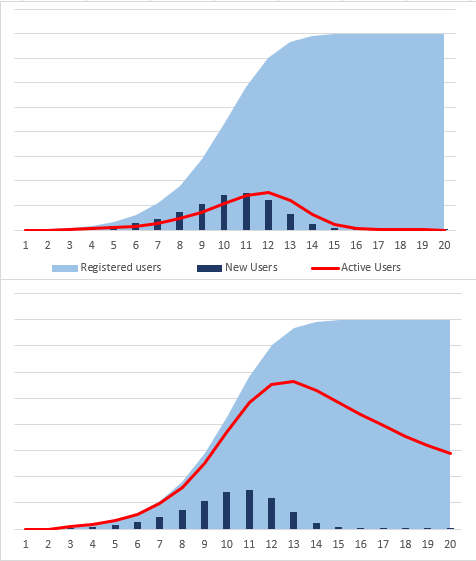- ARPDAUPosted 12 years ago
- What’s an impressive conversion rate? And other stats updatesPosted 12 years ago
- Your quick guide to metricsPosted 12 years ago
The End Of Games Marketing As We Know It
This post was originally published as part of a regular series on gamasutra. It is reproduced here with permission.
Retention is the key measure of success for a free-to-play game. This fact should send a frisson of fear down the spine of games marketers and salespeople across the globe. The truth that their skills are becoming much less valuable in the parts of the industry that are growing, rather than those that are in terminal decline.
Don’t We Need Customers?
All games need customers. Free-to-play games are no exception. How free-to-play games acquire customers, when they ask them to pay and how much they charge them are fundamentally different.
The reason is fundamental: in the world of free-to-play, all customers are different; in the world of packaged goods, they are all the same.
Let’s explore that idea in more detail. When I walk into a GameStop or GAME, the sales assistant can’t scan my brain to work out how a big a fan I am of each of the games in the store. They have no idea if I would be prepared to pay $200 for copy of BioShock signed by Ken Levine or if I have so little interest in the game that I’d only buy it if was priced at a single dollar in the bargain bin.
As a result, marketers and retailers set the price to maximize revenue based on what the averageperson will pay. The amount that customers pay is fixed at a single price point (or perhaps two if there is a Collector’s Edition), so generating revenue becomes a matter of increasing volumes of sales, not in offering a continuum of prices from free up to thousands of dollars.
In fact, the day one launch is absolutely critical: the finance director of a major games publisher once told me that he could predict the lifetime sales of a game to within 10,000 units based on the results of the launch weekend.
Hence the focus on launch hoopla, on event marketing, on generating massive pre-orders and generally trying to shift as many units as possible on the first weekend.
Free-to-play Games Are Different
Free-to-play games are not about launch. A traditional games business cares about getting money out of a customer upfront. Sure, the designers care about building a long, compelling, interactive experience that wins plaudits and prizes, but the commercial team just cares about getting that $49.99 out of the gamer. If they don’t like the game, tough, the publisher already has their money.
(See Pat Garratt’s excellent piece on why publishers manage the review process so carefully for a clear explanation of this process).
A free-to-play game lives and dies on whether it can persuade people to spend money over and over again. On whether it can move players along the curve from freeloaders to minnows to whales. On building long-term retention mechanics into the game.
There are many places where this can go wrong. A free-to-play game can be very dull in the first 20 minutes (this is particularly true when it is made by a team that has graduated from AAA). It can fail to keep people coming for a whole week. It can lose people at many places on the journey.
And every time you lose someone, you lose a player who might become one of your biggest fans. Who might evangelize your game to his or her friends. Who might spend £1,000 on a single item.
Marketing is no longer about the launch. There is no point in a massive launch event that drives millions of players into a leaky funnel. Instead, it is about using metrics, analytics and insight to find the areas of your game that are not working and fix them on a rolling, iterative schedule. The marketing team becomes integrated into the development team, not a silo far away.
If you work in marketing for games, I would suggest that you start retraining. If your skill is managing journalists, building hype or holding parties, that need is urgent.
Marketing is becoming measurable. This is great news for the games industry. It might be terrible news for some individual marketers.














